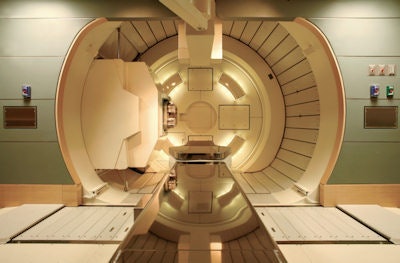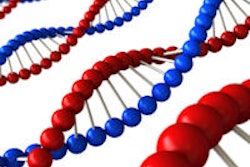
Proton therapy is an ideal fit for pediatric patients, delivering high dose conformality while minimizing the dose to nontarget tissues. But treating children comes with a unique set of challenges and constraints, as Dr. Anita Mahajan explained at the 52nd annual meeting of the Particle Therapy Co-Operative Group (PTCOG 52), held recently in Essen, Germany.
 Dr. Anita Mahajan, medical director for the MD Anderson Proton Therapy Center, at the PTCOG 52 meeting.
Dr. Anita Mahajan, medical director for the MD Anderson Proton Therapy Center, at the PTCOG 52 meeting."Children are not just little adults," said Mahajan, medical director for the University of Texas MD Anderson Proton Therapy Center in Houston, Texas. "The proportions of their body are different, both on the outside and the inside."
Brain development, for example, occurs rapidly during a child's first three years, and the increased radiosensitivity of the brain -- and other maturing organs and tissues -- must be accounted for when planning proton treatments.
Pediatric patients can present with a large variety of tumors, with varying radiosensitivity and location. Another issue is that the tumor size must be considered relative to the patient size, with a 5 cm mass, for example, representing a large proportional volume in a small child. The same goes for any planned margins: "A 1 cm margin may not be a big deal in an adult, but it could well be in a baby," Mahajan explained, who has been treating pediatric patients with protons at the MD Anderson Proton Therapy Center since it opened in 2006.
Minimizing uncertainties
The conformality of proton therapy comes hand-in-hand with the requirement for highly accurate tumor delineation, patient set-up and beam delivery. Treatment plans must pay particular attention to reducing dose to normal tissue, and any normal structures observed on imaging should be delineated for avoidance. For example, it's possible to map functional areas in the brain using functional MRI and then design a beam arrangement to avoid these areas. If possible, information regarding the different susceptibility of tissue at different development should also be incorporated into the treatment plan.
A key part of the setup process for pediatric patients relates to reducing anxiety. This requires a dedicated therapy team and close liaison with anesthetists and other specialists. At MD Anderson, around 60% of pediatric patients are younger than 10, with half of these 5 years old or younger. While anesthesia is generally required for all younger than 5, reduced anxiety may remove the need for sedation in some older children.
Mahajan also pointed out that most external immobilization equipment is designed to fit adults, and children younger than 5 cannot use a bite block. It's important, therefore, to have access to masks and other body immobilization kit that can accommodate smaller patients.
 The gantry at the University of Texas MD Anderson Proton Therapy Center.
The gantry at the University of Texas MD Anderson Proton Therapy Center.The MD Anderson team uses daily kV imaging to increase the accuracy of patient setup. Mahajan emphasizes the importance of using appropriate structures -- whether bones or fiducials -- for alignment. "We need to be careful about what is used to set up the patient and its relationship to the tumor," she said.
Another option would be to use volumetric imaging for patient setup. As such, Mahajan is hoping to install a diagnostic quality CT scanner in the treatment room. While daily CT can reduce the size of the planned target volume (PTV) margins, she emphasized that this must be weighed against the increased dose delivered, as well as the additional setup time and patient anxiety. It's important to use the lowest dose and smallest field size possible. Ultimately, it may be feasible to employ alternative, nonionizing methods for image-guidance, such as surface mapping or MRI.
4D and 5D issues
As well as accurate daily setup, intrafractional movement arising from respiration, bladder filling, bowel gas, and other organ motion must also be addressed. Motion management options reflect those under development for proton therapy in general and include the use of internal target volumes (ITV), gating, and tracking. Mahajan pointed out that it's difficult to develop large programs to evaluate such techniques in children. "I'm going to see how they do this for adults, and copy and adapt it for use in children," she said.
Currently, Mahajan treats most pediatric patients using passive scattering, but she is starting to use scanned proton beams for some cases. She explained that the pencil beam on MD Anderson's proton therapy system currently doesn't have a penumbra trimmer, so while it delivers more conformal target dose, the out-of-field dose may be a little higher in many cases. To address this, the physics team is developing an aperture that will be incorporated into the scanning beam. Once this is installed, many more children will receive scanned pencil beam treatments.
Finally, Mahajan said, one must consider changes that occur within the tumor or patient between fractions-- the so-called 5th dimension. She noted that pediatric tumors can develop particularly rapidly, resulting in tight time constraints for starting treatment. Once therapy has begun, tumors may well shrink and the patient may lose or gain weight. Monitoring such changes and performing adaptive replanning can help reduce dose to normal structures.
The number of pediatric proton cases is growing year-on-year. The proportion of extracranial treatment sites is also increasing, with more treatments in motion-prone areas such as the thorax, abdomen, and pelvis. To maximize the potential benefits of particle therapy for pediatric patients, we need to incorporate lessons from both the photon and the adult proton worlds, Mahajan concluded.
Related links
© IOP Publishing Limited. Republished with permission from medicalphysicsweb, a community website covering fundamental research and emerging technologies in medical imaging and radiation therapy.



















